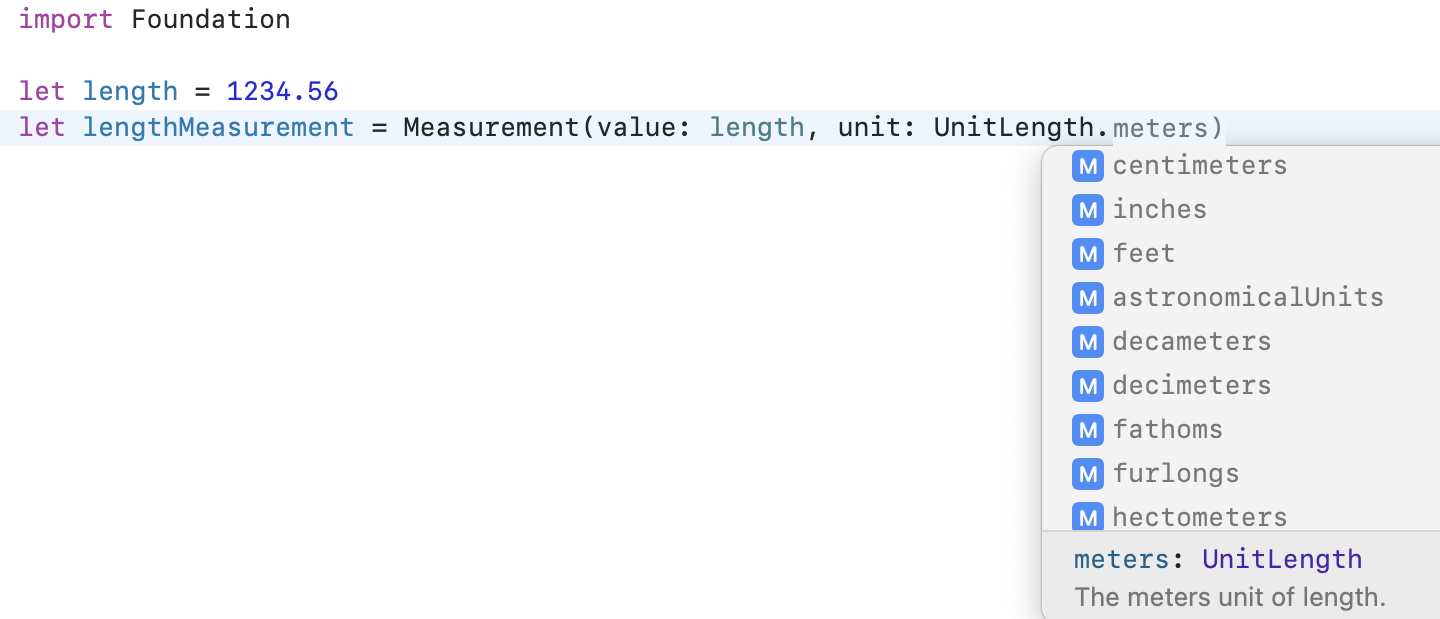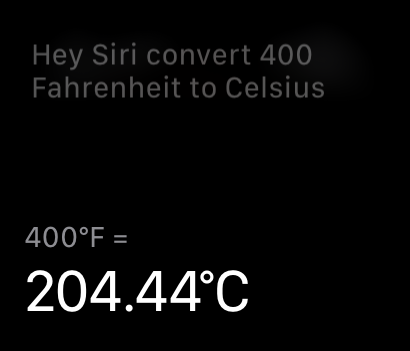Swift Measurements
16th April 2025 • 665 words • 4 minutes reading time.
Recently, I was working with units and unit conversions in Swift. After a while, I then remembered that Swift has a built-in structure for doing this: Measurement. This article is an introduction to the power and usage of Measurement.
To use a Measurement, you initialize it with a value and a unit type. The value must be a Double and the unit type specifies the type of measurement and the scale of the units. Here's an example of specifying a length in centimeters:
let length = 1234.56
let lengthMeasurement = Measurement(value: length, unit: UnitLength.centimeters)There are many supported unit types. They all begin with Unit, so start typing and see what you get. Once you have the unit type, enter a period and code completion will suggest all the possible units for that type. There's a huge range, including some very obscure ones:

I'm running this in a playground and when I print lengthMeasurement I get 1234.56 cm as you'd expect.
The magic happens when you start formatting the Measurement.
let formattedLength = lengthMeasurement.formatted()
print(formattedLength)Running this code gave me 12 m which is a much more readable version.
Playing around with larger and smaller values, I got it to show cm, m or km. It even added in the thousands separator when I went to a really big number. Strangely, I couldn't get it to use a smaller unit than the one I started with. Even with 0.00001 cm, it still didn't use mm, so I guess the lesson there is to start with the smallest units you want to show.
Now for the super cool bit. I went into System Settings -> General -> Language & Region and changed Measurement system from Metric to US. Running the playground now, my original value of 1234.56 cm gave a formatted value of 41 ft! A larger value gave me mi (miles) and a smaller one showed in (inches). So the formatting uses the system setting to choose what units to show. There's no need to convert measurements to suit your user's locale - a formatted Measurement does that for you!
Converting
But what if you want to show the conversion? I like to cook and most recipes online assume the everyone uses Fahrenheit for their ovens. My thanks to all the recipe writers who show Celsius as well, it's greatly appreciated.
As you can imagine, I spend some time in the kitchen talking to my wrist so that my Apple Watch and Siri can do the conversion for me:

In this screenshot, the result of my query shows both Fahrenheit and Celsius. Let's try that in the playground.
Firstly, Measurement can do conversions, like this:
let fahrenheit = 400.0
let fahrenheitMeasurement = Measurement(
value: fahrenheit,
unit: UnitTemperature.fahrenheit
)
print(fahrenheitMeasurement)
let celsiusMeasurement = fahrenheitMeasurement.converted(to: .celsius)
print(celsiusMeasurement)This prints 400.0 °F and 204.44444444444832 °C. If you need to access the numeric result of the conversion, you can get the Double using celsiusMeasurement.value.
But as you'd expect, if you use formatted, both versions are shown in Celsius because that's my system setting:
print("\(fahrenheitMeasurement.formatted()) = \(celsiusMeasurement.formatted())")This prints 204.444444°C = 204.444444°C which while factually indisputable, is not at all helpful. And it shows far too many decimal places - my oven is not that accurate!.
Here's where we can use a MeasurementFormatter which allows us to specify several parameters:
let formatter = MeasurementFormatter()
formatter.unitOptions = .providedUnit
formatter.numberFormatter.maximumFractionDigits = 0
formatter.unitStyle = .mediumWith this in place, I tried:
let formattedFahrenheit = formatter.string(from: fahrenheitMeasurement)
let formattedCelsius = formatter.string(from: celsiusMeasurement)
print("\(formattedFahrenheit) = \(formattedCelsius)")And got 400°F = 204°C which is even more useful for cooking than the display my watch showed.
The key for showing both temperatures was to set the unitOptions to providedUnit which made it use the unit specified in the Measurement.
After that, numberFormatter is a standard NumberFormatter with all its options. unitStyle can be short, medium or long. The default is medium but I specified it so I could experiment with the different styles.
So any time you find yourself working with units and conversions, give Measurement a try. It handles localization, conversion and formatting for you.
If you have any feedback about this article, please contact me using one of the links below or through the Contact page. And if you found this useful, please buy me a coffee.